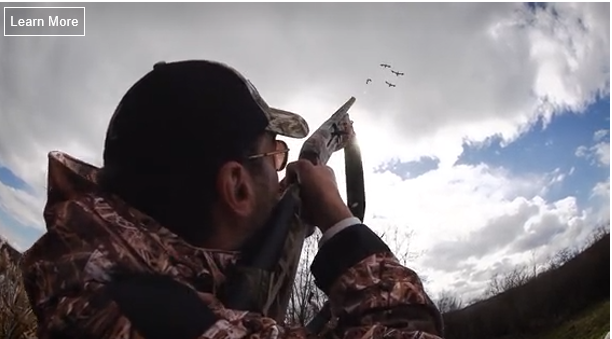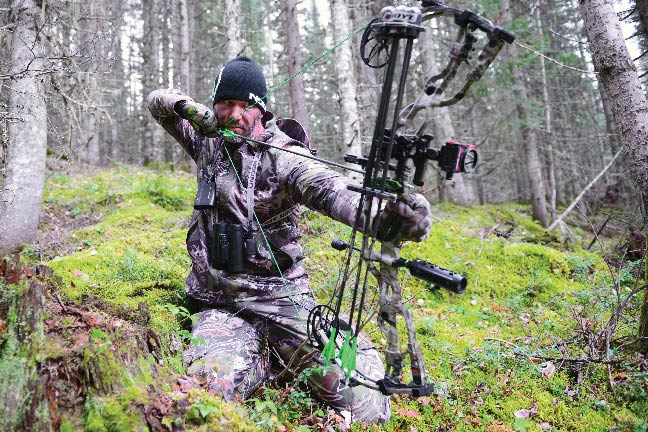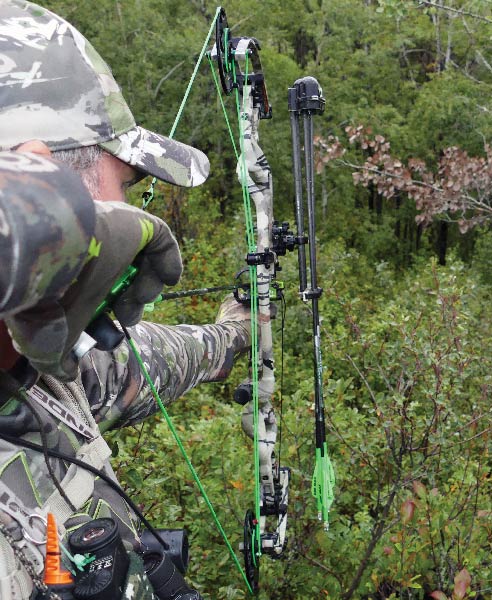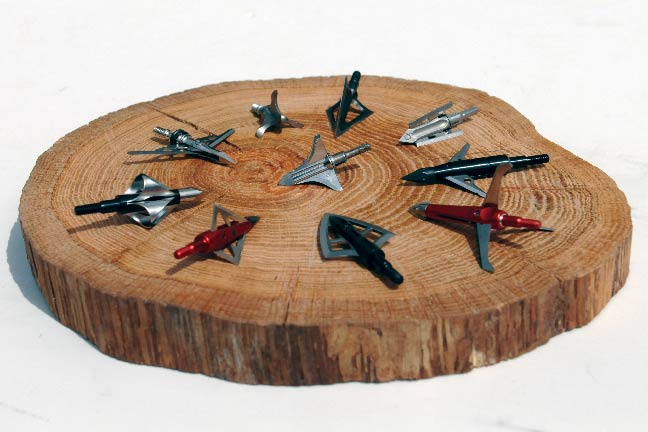Rookie Mistakes - Letting past failures be your friends.

This past season, author John Dudley avoided another disaster in British Columbia by making sure his broadheads were dialed in before his bear hunt.
After months in the treestand, seeing nothing but birds, raccoons and opossums, I finally saw a glimmer of antlers in the Illinois marsh. It was a buck worth waiting for: a giant, mature 10-pointer. The early season had passed, as had the peak rut. At this point, it was a longshot for me to even see a deer - let alone the one I had dreamed about for years. He was cruising the one trail leading to the only stand I got permission to hang. He was a needle in a haystack, but luck had us 30 yards apart, and he was closing the distance one step at a time. My heart was beating like a drum; I felt it in my throat and would swear the buck could have heard it too. I had my first new bow in my hand, and the opportunity to put it to use was seconds away.
With my heart in my throat and quivering hands, I raised my bow and began to draw. I pulled harder and harder on the string as the buck continued its approach. He was now less than five yards away. As each second went by, I quivered and strained and pulled and tugged, yet the string did nothing. It was frozen like a piece of concrete! I stopped pulling and pointed the bow right at the buck, which was now directly under my tree. This time, I really leaned into it and gave it everything I had. As I pulled and tugged and tried to compose myself, the buck just casually walked away at a perfect shot angle one step at a time until, finally, he was out of range. I almost cried. What the heck happened?
Well my friends, I`ve done some stupid things that have cost me big time in the woods, and this was one of the first, and worst, rookie mistakes. This article is all about the things I`ve done wrong as a bowhunter and what I have learned to do differently so that I have success rather than another story of the one that walked away!
Manage Your Weight
The story I just told you is true. I was a teenager and had saved up to buy my first bow. I had others, but they were all hand-me-downs.

.
This was my first [new" bow. I was young and was lured in by its impressive speed. Much like my motorcycle, I wanted something faster than my friends. I didn`t think about accuracy or practicality when I bought that 80-pound bow. As I wrote this article, I Googled this model to find the specs, and one of the first comments I found in an online forum was this description of the bow: [The [bows] were wrist-slapping rockets in their time-very radical, high-reflex designs with low brace heights that made them very critical to fit and form for good accuracy." Well, to whoever wrote this, you are right on the money with that description!

Don`t be afraid to back down your draw weight to ensure you can still draw your bow under adverse conditions in the field.
My mistake was not the bow; it was my ego and not knowing how to manage my draw weight. The part of the story I left out was the ending. Once the buck walked out of sight and my nerves settled, I gave the bow one last tug to see what the heck was going on. And guess what? I pulled it back. The problem was that the draw weight was at my maximum, not what was easy. It`s like working out in the gym. Sometimes you can do your max weight, and other days you just can`t. If you set up your bow to where it is achieving max velocity with your maximum effort, it may come at a serious price of missing your only opportunity of the season.
Looking back, I realize I couldn`t pull the bow very easily in practice and often had to raise the bow to the sky to draw it back. My practice time was limited to how many times I could pull the bowstring back.
The wise choice is to shoot a bow you can pull back while in a seated position while the bow is on a level plane. If you have to raise the bow high, lean back as you draw or thrust your hips and shoulder forward to get it back, then you aren`t managing your weight. Learn from my mistake and hunt with a draw weight you can control in any condition, and you will be able to make the shot you need, when you need it.
Look to the Future
I was 10 miles deep into a huge Alberta river basin. The GPS showed we had hiked more than 70 miles looking for a chance at an elk. We were exhausted, wet and had about an hour of daylight remaining on the last day of the hunt. Yup, things were looking pretty bleak!

Experience has taught John Dudley to become more successful by anticipating the future. Study the animal`s direction of travel and already be anchored at full draw when the shot opportunity arises.
I let out another bugle, expecting to hear nothing in return, since that is exactly what I had heard the previous seven days. Yet this time, a bull fired up and bugled back on top of mine. He was close, and honestly, it was so unexpected I bugled right back just to confirm I wasn`t hearing things. Once again, the bull lit up with a scream noticeably closer than the last. We headed his way and quickly found a little spot to set up. The bull bugled once again, looking for our location. This time I stayed quiet, hoping curiosity would get the best of him. My buddy tapped me on the shoulder and pointed in the direction of the bull. I could see the tan fur passing through the trees. He was totally committed to coming and was already within range.
It was pretty thick, so I just waited for him to pop into an opening. When he stepped into my shooting lane, I quickly drew the bow. The bull spun around, looking right at me. I was busted, and there was no ethical shot angle. He took about two seconds to look at me, then barked and bolted. What a disappointment! So many miles and so many days, only to get busted drawing my bow. The valuable lesson I learned here is to draw the bow and settle into your shot before the opportunity is there. This goes with any type of hunting. If you have shooting lanes or openings, then really key in on being at full draw and waiting in that window before the animal is there. If you try to do it when the animal is there, it`s simply too late.
One other thing to point out is that your ability to do this goes hand in hand with my first point in this article of managing your weight. If you shoot a draw weight you can easily manage, then drawing back and waiting for your shot won`t be a problem. Look to the future and be waiting for your shot opportunity when it shows up!
Don`t Believe the Hype
As bowhunters, it`s tempting to take the easy way out sometimes, especially when it comes to our equipment. I`ve been there with you, and unfortunately you can`t always believe the advertising hype. One year, I saw this ad with a deadly looking broadhead and claims that it [flies exactly like a fieldpoint." Well, I was the first in town to buy some, and since they weren`t cheap, I kept them flawless in their package until I got up to British Columbia, where I was chasing black bears.

Don`t believe every marketing claim made by broadhead manufacturers. Although most broadheads fly quite well when properly tuned, you should never hunt until you`ve shot them with your particular bow/arrow combination to confirm reliable accuracy.
We covered a lot of amazing country up at the start of the Rockies and found a giant bruin out feeding on fresh greenery in this big logging cut. I made the perfect stalk and had everything in my favor for a perfect kill shot. I drew back, settled the 40-yard pin and released. The arrow flew way off the mark, and the bear ran off. I looked back at my guide, who was operating the video camera. He had this classic look on his face that screamed, [Jeez, that was a bad shot!"
I couldn`t believe I had missed the entire animal. I quickly grabbed the camera and said, [Let`s watch that again." The video showed the arrow clearly flying way off target. We retrieved my arrow, and I told my guide to head back to camp where I could shoot it at a target. Well, the proof was in the pudding. That arrow wouldn`t even hit the Block Target past 30 yards with that broadhead. Although it looked cool, the truth was it flew like crap, and with my arrow and speed, it was arguably unethical to even launch it! My mistake was probably the most common of them all - not trying broadheads before taking the field.
Once I returned home from that hunt, I did an experiment and realized just how much this can be a problem for bowhunters. I took a bow of mine that would shoot great groups with fieldpoints and put several types of broadheads on the arrows. Most would not group with my fieldpoints. The broadheads would group with themselves, if they were all the same, but broadhead A had a mind of its own compared to broadheads B, C and D. Some flew right, some left and others would be high or low. It was eye opening that all these heads were doing something different.
After that, I started really experimenting with fletching choices and how it affected broadhead flight. There were a lot of variables, and some combinations were certainly better than others.
My advice is to never blindly believe the packaging when it comes to the accuracy of your broadhead. Buy an extra pack and try them for yourself. [Fieldpoint accuracy" may be true for a bow shooting 250 fps and arrows with four-inch vanes, but will most likely be different for a bow shooting 300 fps arrows with two-inch vanes. You will only know for sure once you try it. Pre-season is the best time to do these tests. I guarantee you will be a more accurate, more ethical and more successful bowhunter because of it.
My Failures, Your Friends
Thankfully, as I`ve matured as a bowhunter, those mistakes do occur less frequently. My goal is to let you learn from my mistakes, so when you finally have that dream buck walk under your stand, you will easily draw your bow and make a great shot. I want to make sure that when that screaming bull elk is standing right in front of you, your pin is already waiting for him with your finger on the trigger. Finally, I want you to see your broadhead split that small hair behind the shoulder when that giant black bear is broadside.
Doing what I do for a living allows all of you to see my blessings in the outdoors. Often times, seeing my successes clouds people`s perspective and hides the fact that it`s not all rainbows and unicorns. I make mistakes all the time - just like you - and am humbled regularly.
There`s an old adage that says you have to [live and learn." But hopefully you don`t have to do that like I did. I say, [READ and learn!"
Read more: http://www.bowhuntingmag.com/tactics/avoiding-the-most-common-bowhunting-mistakes/#ixzz5GjpdQmEZ
Hunting clothes is a camouflage option for hunters wanting to reduce detection from game. Clothing also protects hunter against weather and environment conditions. Clothing options include jackets, pants, glasses, facemasks, gloves, and waders.
Hunting Clothing is perfect for all environments and hunting sport!
Hunting Clothing
Hunting Clothing,Camo Clothing,Camouflage Clothing,Hunting Apparel
CONQUEROR OUTDOORS 01- (562) 524-2002 , http://www.conquerorcrossbow.com